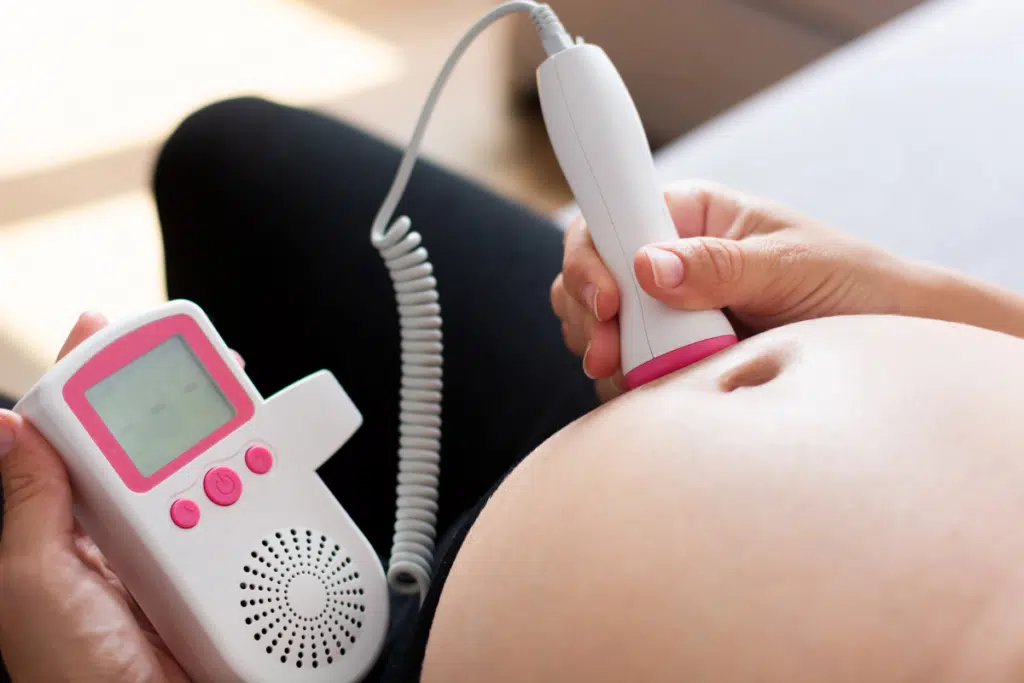
Content Reviewed by:
Dov Apfel
Content Reviewed by: Dov Apfel
Accordion Content
Since 1979, Dov Apfel has been passionate about advocating for birth injury and medical malpractice victims. Mr. Apfel’s career-long record of achievements in birth injury litigation, education, and advocacy has been recognized by the Executive Board of the Birth Trauma Litigation Group of the American Association for Justice. His expertise is demonstrated by his numerous awards, presentations on birth injury topics at legal conferences for organizations like the AAJ and ATLA, and articles published by Trial Magazine and many others.
When signs of fetal distress are present during pregnancy or childbirth, swift action is necessary to prevent serious harm, including brain damage and death. The most common sign of fetal distress is a change in the fetal heart rate. Reduced amniotic fluid volume or meconium in the amniotic fluid also indicates fetal distress. When fetal distress is properly managed, it is possible to have a healthy baby free of ill effects.
Fetal distress may occur at any point during pregnancy or childbirth. A reasonably diligent prenatal health care provider should be able to detect fetal distress through heart rate monitoring and investigation of symptoms reported by the mother.
What Is Fetal Distress?
Fetal distress is a non-specific term that describes signs that something is wrong, usually pointing to a deprivation of oxygen.
The healthcare industry considers the term “fetal distress” vague and inaccurate. Consequently, most providers have adopted a new term, non-reassuring fetal status, or NRFS. Fetal distress could indicate a serious problem needing immediate attention.
Warning Signs of Fetal Distress
Recognizing the warning signs of fetal distress as soon as they occur is critical in ensuring a positive outcome. A distressed fetus could be suffering from a lack of oxygen, which can quickly lead to brain damage. It may occur during pregnancy or childbirth.
Fetal Distress During Pregnancy
Any unusual symptoms or changes during pregnancy should be reported immediately to a doctor to rule out fetal distress or other serious complications.
Changes in Fetal Heart Rate
The most common sign of fetal distress is a slowed fetal heart rate, as detected through monitoring. This is known as bradycardia and could indicate the baby is not getting enough oxygen. Tachycardia, or rapid heart rate, could also indicate distress. The average heart rate for a fetus is 110 to 160 beats per minute.
Reduced Fetal Movement
Any decrease in fetal movement is cause for concern and can be an early sign of fetal distress. It should be reported to the prenatal care provider and investigated immediately. A doctor may perform a nonstress test in response to decreased fetal movement. This is a non-invasive test during which the fetal heart rate is monitored during movement. If contractions are occurring, the fetus’s response to the contractions and the fetal heart rate during and after the contractions will also be recorded.
The heart rate should increase during movement, then quickly return to baseline. Further testing is warranted if the heart rate fails to follow this pattern.
Low Amniotic Fluid
Low amniotic fluid, known as oligohydramnios, may be detected during an ultrasound and could indicate a problem with fetal growth or a genetic disorder. It can prevent the baby’s lungs from developing and increases the risk of umbilical cord compression. This could deprive the baby of oxygen and result in brain and organ damage.
Early delivery may be recommended if low amniotic fluid is diagnosed after 36 weeks of gestation.
Vaginal Bleeding
Vaginal bleeding during pregnancy is abnormal and may indicate a serious complication. In early pregnancy, vaginal bleeding is associated with miscarriage and ectopic pregnancy. Both of these conditions are medical emergencies for the mother. The fetus generally cannot survive either of these conditions.
In late pregnancy, vaginal bleeding could indicate placental abruption, a separation of the placenta from the uterine wall. This can indicate that the fetus is deprived of oxygen and nutrients, which may cause dangerous hemorrhaging in the mother.
Fetal Distress During Pregnancy
Fetal distress during labor and delivery is most commonly diagnosed by monitoring the fetal heart rate. Maternal bleeding or discoloration of the amniotic fluid can also indicate it.
Fetal Heart Rate During Labor
During labor, it is normal for the baby’s heart rate to decrease during contractions in response to reduced oxygen. In most cases, the baby recovers between contractions without harm.
However, if the contractions occur too close together for an extended period or the placenta is functioning poorly, the baby may be unable to recover between contractions. This will decrease the heart rate even more during contractions and may also reduce the baseline heart rate.
A decreased heart rate may indicate that the baby’s brain and other tissues are being deprived of oxygen. A hastened delivery or Caesarian may be necessary to prevent permanent disabilities or stillbirth.
Meconium
Meconium is the baby’s first bowel movement. This usually occurs shortly after birth, but a fetus experiencing distress may pass meconium in the womb before or during labor. Amniotic fluid is normally clear. If the amniotic fluid is green or brown, meconium is present.
Meconium in the amniotic fluid may be a warning sign of fetal distress and requires investigation. If the baby inhales a mixture of amniotic fluid and meconium, there is a danger of meconium aspiration syndrome. This is a life-threatening condition that occurs as a result of meconium entering the baby’s lungs.
Meconium aspiration syndrome occurs in five to ten percent of births and is one of the most common causes of severe illness and death for newborns.
Excessive Bleeding
Sudden, excessive bleeding during labor could indicate a rare condition known as vasa previa. This condition occurs when unprotected blood vessels from the umbilical cord run through the cervix. Any event during labor, including the water breaking, could cause these blood vessels to rupture, resulting in significant bleeding.
Since this is the primary source of the baby’s blood supply, it can result in rapid death of the fetus if doctors fail to take immediate action. This condition requires an emergency Cesarean.

What Causes Fetal Distress?
Any condition that prevents the flow of blood and oxygen through the placenta and to the baby may cause fetal distress, including the following:
- Placenta previa – When the placenta partially or completely covers the cervix
- Umbilical cord compression – A pinched or pressed umbilical cord that prevents the flow of blood, oxygen, and nutrients to the fetus
- Umbilical cord prolapse – Entry of the umbilical cord into the cervix during delivery ahead of the baby, resulting in the cord becoming compressed
- Labor-inducing drugs – Drugs such as Pitocin are used to initiate labor, which can result in contractions that are too strong or too close together
- Labor that is difficult, excessively rapid, or excessively long
- Fetal anemia – Reduced hemoglobin and red blood cells in the baby
- Low amniotic fluid
- Pregnancy hypertension or preeclampsia
- Death of the mother
Conditions that cause the mother to hemorrhage may also cause fetal distress, such as a uterine rupture. A uterine rupture occurs when the uterus becomes torn, often during delivery and along scar tissue from a previous Cesarean. Fetal distress is often the first symptom of uterine rupture.
Risk Factors of Fetal Distress
A risk factor is a condition that may not directly cause fetal distress but could make it more likely. The following characteristics are associated with a higher risk of fetal distress:
- Pregnancy that lasts too long
- Low birth weight
- Improper birth position, such as a breech delivery
- Gestational diabetes
- Chronic health conditions in the mother
- Pregnancy with identical twins
- Premature birth
- Being non-white
- Marginal cord insertion -When the umbilical cord is not properly attached to the placenta
- Placenta Accreta – the placenta growing into the uterus
- Iron-deficiency anemia in the mother during the third trimester
Effects and Complications of Fetal Distress
When not promptly treated, fetal distress can result in the following catastrophic harm to the fetus:
- Hypoxic ischemic encephalopathy, or HIE
- Stillbirth
- Cerebral palsy
- Newborn seizures
- Epilepsy
- Learning disabilities
- Difficulty with balance or coordination
- Speech and language problems
- Blindness
Can Fetal Distress Be Prevented?
When fetal distress occurs, there is generally nothing a mother could have done to prevent it. A doctor may reduce the risk by monitoring a mother’s health during pregnancy and treating conditions such as iron-deficiency anemia that can increase the risk of fetal distress.
Research published by the United States Office of Health Policy has found that hiring a doula during labor can improve the outcome for both the mother and the infant. A doula is a professional who provides physical and emotional support and advocacy during labor. This can be especially helpful for women of color who often face disparate treatment in the medical system.
Treatment for Fetal Distress
Fetal distress requires fast, decisive action. The treatment depends on the cause of fetal distress and whether it occurs during early pregnancy, late pregnancy, or childbirth.
Managing Pre-Labor Fetal Distress
When fetal distress occurs during late pregnancy, an emergency caesarian or induced labor may be required.
If fetal distress occurs before the baby is ready to be born, a doctor may order bed rest or medication to protect the fetus and the mother until a safe birth can occur.
Managing Fetal Distress During Childbirth
If fetal distress occurs during childbirth, simple measures such as providing intravenous fluids or supplemental oxygen to the mother may provide relief. If fetal distress occurs while a mother is lying on her back, changing the mother’s position may help.
Fetal distress caused by strong contractions from labor-inducing drugs may be treatable by stopping or slowing the administration of these drugs. The drug terbutaline can be administered to slow or stop contractions.
Sometimes, it is necessary to hasten delivery to alleviate fetal distress. This must be done quickly to prevent brain damage. A vacuum or forceps-assisted delivery may be sufficient in less severe cases, but sometimes, a Caesarian delivery is the only safe option.
Resources and Support
The organizations below provide information and support to women, families, and children who have faced traumatic birth experiences, birth injuries, or the loss of a child through miscarriage, stillbirth, or infant death.
- March of Dimes support groups for parents of children born prematurely
- Cerebral Palsy Resource – An educational service for parents and caregivers of children with cerebral palsy
- The Arc of Illinois – Support and financial assistance for families with special needs children, including financial help with assistive technology for individuals with intellectual and developmental disabilities
- Family Resource Center on Disabilities – Information and assistance for parents of children with disabilities
- Child Neurology Foundation – Support and advocacy for children and families coping with neurological conditions
Legal Recourse for Birth Injuries
If you or your child has suffered harm because of improperly managed fetal distress, you may be able to recover financial compensation through a birth injury lawsuit. Our compassionate and skilled attorneys at Levin & Perconti can help. Contact us today to schedule a free case evaluation.



